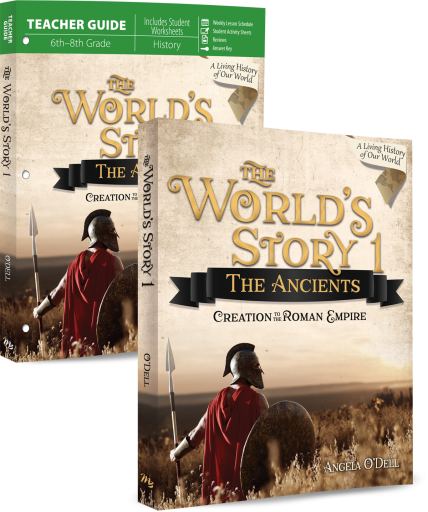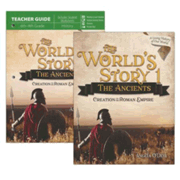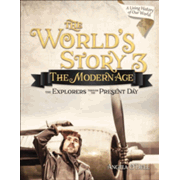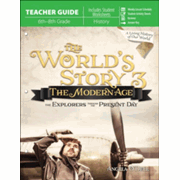A Living History of Our World series covers both U.S. and world history. You can read my review of the America's Story portion of the series which covers U.S. history and is written for grades three through six. In this review, I focus on The World’s Story, a series of three courses covering world history from creation to the present day for students in grades six through eight. Each course has a textbook and a teacher guide. The world history courses are:
The World’s Story 1: The Ancients (Creation to the Roman Empire)
The World’s Story 2: The Middle Ages (The Fall of Rome through the Renaissance)
The World’s Story 3: The Modern Age (The Explorers through the Present Day)
Author, Angela O’Dell, titles the entire series A Living History of Our World since it reflects Charlotte Mason’s recommendation that history, as well as other subjects, be taught with what she described as living books—books that are lively and interesting. For history, this means reading the stories of history rather than just names, dates, and events. To that end, O’Dell writes in a very personal, storytelling style that should appeal to students, very much reflecting Charlotte Mason's approach.
The reading level of the textbooks is essentially the same through all of these courses. Because these textbooks use a storytelling approach mixed with summaries of historical events, the historical coverage is not comprehensive. Even so, students will learn about many of the main events and key people.
This series is written from a strongly Christian perspective. This is evident, for example, in the attention given to scriptural accounts of history used in the first textbook and in the ubiquitous inclusion of church history throughout the second textbook. The church history throughout this series presents a decidedly Protestant viewpoint. The second textbook has some weaknesses in regard to the accuracy of its treatment of some events in church history as well as theological of the beliefs of different Christians. For instance, on page 267 O’Dell implies that a mild disagreement regarding the Eucharist was the only difference between Luther and Zwingli. In actuality, they disagreed vehemently on a number issues that resulted in deep and lasting divisions within Protestantism. The World’s Story 2 misrepresents Catholic teaching a few times, such as in this description of indulgences on page 255: “Indulgences were certificates that exempted the owner from having to do penance. The selling of these certificates became a business all over Europe. Citizens could literally buy the right to sin.” These defects will be insignificant to some homeschoolers and major issues for others.
The World’s Story 1: The Ancients draws on biblical history to relate the story of creation and the first people, followed by the worldwide flood. Places, people, and events referred to in the Old Testament receive far more attention in this textbook than in most other world history courses, to some extent displacing the broader scope of history. We learn the most about ancient Israel along with ancient Egypt, Greece, and Rome. However, aside from one chapter on ancient China and a short chapter that combines information on ancient Africa and Celtic civilizations, other ancient civilizations such as India and Japan are ignored. You might want to supplement with stories from The Story of the World Volume 1 or another resource to broaden coverage.
The World’s Story 2, which covers the fall of Rome through the Renaissance, primarily addresses western civilization as does the first volume, but it also includes chapters on the rise of Islam, Indian dynasties, and events in China, Korea, Japan, Africa, Central America, and South America during this time period.
The Worlds' Story 3 continues from the age of the explorers to modern times.
The softcover, non-consumable textbooks are printed in full-color and are heavily illustrated with photos, maps, reproductions of artworks, and other images. I find the numerous photos of still-existing, ancient structures especially fascinating. The textbooks each include an index, which I find very helpful.
The teacher guides have some teaching information as well as an answer key at the back, but they serve primarily as the source for reproducible activity pages to be handed out to students. These three-hole-punched pages can be removed and put into a binder. Since there are more than 300 such pages in each teacher guide, you might want to buy an additional copy of the teacher guide for each extra student rather than copy so many pages.
The teacher guides also have cumulative review quizzes to be used after four scheduled review days. Quizzes have both multiple-choice and essay questions.
Narration, a key element in Charlotte Mason's methodology, plays a prominent role throughout this series with frequent narration breaks in the textbooks where the student should present an oral narration to a parent about the material they have just read. Key points that should be included in those narrations are provided for parents in the teacher guides. Students will also do written narrations, but those are done after reading an entire chapter. While you can read the text aloud together, students will probably prefer independent reading. However, you still need to require oral narrations as indicated by “narration breaks” within chapters.
Charlotte Mason purists need to be aware that some activities are more prescriptive than Mason would have used. They ask for more-structured and predictable responses from students than Mason would. Still, the approach used in The World's Story is balanced in a way that many parents will appreciate. It gives parents a clear idea of what students should do, while still allowing flexibility.
Teacher guides have a teacher page for each chapter. The teacher pages each have a list of objectives, a materials-needed list, and suggested responses for oral narrations. Sometimes there will also be a brief note to the teacher.
Following the teacher page for each chapter are a number of reproducible activity pages. Among each chapter's activities are a prompt for a written narration, a sketching assignment, a graphic organizer to complete, questions that require brief-answers, essay questions, map activities, copywork, art studies, and vocabulary work. All types of activities are not included for every chapter
Timelines are so important in these courses that they are included for every chapter, However, rather than having students create timelines, these courses have them study visual timelines and answer questions by referring to them.
Optional Digging Deeper suggestions in the teacher guides almost always involve research and a presentation in either a written or oral report. Research Aid worksheets and Artifact Studies worksheets at the back of The World’s Story 1 can be used for some of the Digging Deeper activities. In The World’s Story 2, Artifact Studies worksheets are replaced by Architecture Studies. Research Aid worksheets should be especially helpful for students doing research for the first time, but those students will likely need more parental direction than is given in the chapter material. (The Getting Started information at the beginning of each teacher guide has instructions and tips for using these courses that might help parents to some extent with guiding student research.)
A number of craft ideas in the back of each book might be substituted for Digging Deeper activities. Activities such as building a sugar cube pyramid, making a salt dough map, or creating an apple mummy (from The World’s Story 1) might be fun, but you won’t be doing these every week. Most of the craft activities are not as educationally worthwhile for students in middle school as they might be for younger students.
These courses require much more writing and critical thinking than do the America’s Story courses since they target an older audience. The numerous opportunities for research and writing will definitely stretch students’ knowledge and skills if parents take advantage of them. (Because of the numerous options for further research and writing, you might even use these courses at high school level if you give students enough challenging assignments.) Parents will need to choose carefully those assignments most appropriate for each student. Because these courses are dependent upon the quality of a student’s written work rather than traditional tests, a grading rubric is included in each teacher guide.
The design of these courses is especially well-suited to homeschooling situations. Each course can be easily adapted to use with children across a range of grade levels. Students can work independently through much of each lesson, but there are enough written and oral response opportunities for parents to be aware of what and how well students are learning.
















